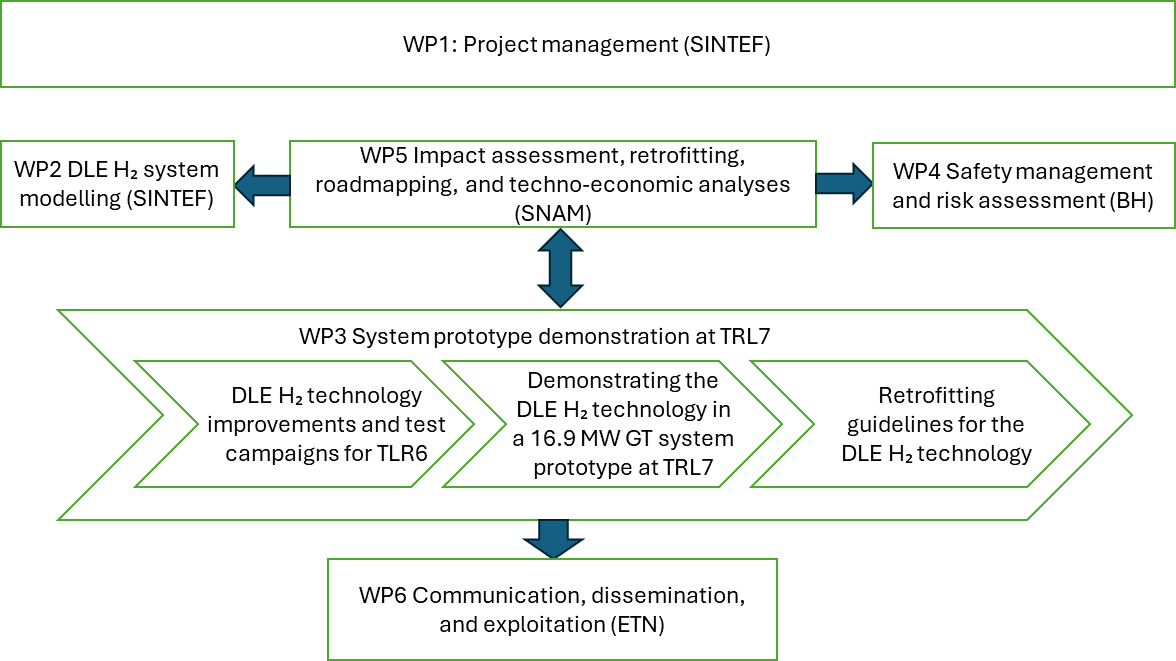HyPowerGT is planned to last 48 months – from January 2024 to December 2027.
It is divided into 6 Work Packages (WP) that are mutually related.

WP1 main objectives are:
- Ensure proper overall management and coordination
- Support participants in achieving the objectives and KPIs
- Establish the required implementation plan with subsequent revisions (as appropriate)
- Establish a data management plan with the required updates
- Ensure that deliverables are submitted according to plan and budget
- Ensure that contractual obligations of the consortium comply with EU regulations
- Ensure that legal requirements abide by best practices of resource management (cf. Financial Guidelines)
- Establish a platform that facilitates effective internal communication
- Foster an integrative process within the consortium
- Identify early warnings of risks and initiate proportionate mitigation measures and contingency plans
- Define measurable indicators for progress reporting
WP2 main objectives are:
- Improve robustness of the DLE H2 combustion system design
- Improve turbulent burning-rate pressure scaling for lean premixed hydrogen-air flames
- Characterise thermoacoustic response within a full range from atmospheric to high-pressure conditions
- Ensure dynamic flame stabilisation and stable operations
- De-risk the DLE H2 combustion system via advanced modelling of the burning rate and thermoacoustics
- Adapt estimates and modelling to conditions relevant to the DLE H2 combustion system operations
WP3 main objectives are:
- Improve the combustion system and prepare test sites and subsequent test campaigns
- Demonstrate the DLE H2 combustion system with up to 100% hydrogen at TRL6 in SestaLab
- Provide a system prototype to demonstrate the DLE H2 technology equipped with tanked hydrogen
- Demonstrate the DLE H2 technology in an engine system running with 0-100% H2 at TRL7
- Aggregate at least 60 fired hours of engine testing with the DLE H2 technology (not continuous testing)
- Develop plant integration concepts to enable operation of retrofitted GTs with up to 100% H2
- Confirm fulfilment of the objectives and KPIs
WP4 main objectives are:
- Ensure proper risk management and re-evaluation for retrofitting gas turbines with DLE H2 technology
- De-risk, improve, and reinforce the design features of the DLE H2 technology during transient phases
- Conduct complementary risk analyses pertaining to HSE assessment
- Conduct failure mode, failure effects, and criticality analyses pertaining to the DLE H2 technology
- Analyse and identify specific risk factors (damage factors and de-risking measures) for H2 gas turbines
- Provide procedures for risk management and evaluation for retrofitting turbines with DLE H2 technology
- Develop a safety management plan that enables operation of retrofitted GTs with up to 100% H2
- Perform plant specific safety analyses at test site
- Assess risk abatement measures at condensers in the chimney
WP5 main objectives are:
- Develop an exploitation roadmap for H2-fired gas turbines utilising the targeted DLE H2 technology
- Emphasise potential retrofit markets and emerging markets in need of new capacities
- Define pathways towards these prospective markets
- Develop a strategic plan for early market uptake with candidate first-movers
- Develop scenarios for strategic showcases by 2030, positioning (2030+), and transitioning (by 2050)
- Identify knowledge and technology gaps and associated risks
- Identify further needs for R&D and measures of political, financial, commercial, and societal nature
- Establish structural plans as to how the technology can be positioned to obtain expected impacts
- Assess options for the support of third-party engine manufacturers via licencing arrangements
- Conduct life cycle sustainability analyses of the expected impact defined in the roadmap
- Ensure availability of CHP data for GT+CHP plant simulation (digital twin)
- Assess impacts of retrofitting a GT+CHP plant with the DLE H2 technology for operations with H2
WP6 main objectives are:
- Raise awareness of the project activities and objectives
- Disseminate project results to relevant stakeholders
- Promote the project and its benefits to a wider audience
- Consolidate synergies with other EU-funded projects and other initiatives
- Present pathways for integration of specific results into EU policies
